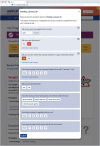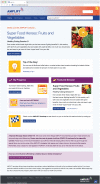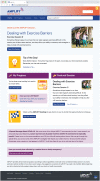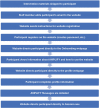Using the TIDieR checklist to describe development and integration of a web-based intervention promoting healthy eating and regular exercise among older cancer survivors
- PMID: 37434730
- PMCID: PMC10331096
- DOI: 10.1177/20552076231182805
Using the TIDieR checklist to describe development and integration of a web-based intervention promoting healthy eating and regular exercise among older cancer survivors
Abstract
Objective: To facilitate replication and future intervention design of web-based multibehavior lifestyle interventions, we describe the rationale, development, and content of the AiM, Plan, and act on LIFestYles (AMPLIFY) Survivor Health intervention which provides healthy eating and exercise behavior change support for older cancer survivors. The intervention promotes weight loss, improvements in diet quality, and meeting exercise recommendations.
Methods: The Template for Intervention Description and Replication (TIDieR) checklist was used to provide a comprehensive description of the AMPLIFY intervention, consistent with CONSORT recommendations.
Results: A social cognitive theory web-based intervention founded on the core components of efficacious print and in-person interventions was conceptualized and developed through an iterative collaboration involving cancer survivors, web design experts, and a multidisciplinary investigative team. The intervention includes the AMPLIFY website, text and/or email messaging, and a private Facebook group. The website consists of: (1) Sessions (weekly interactive e-learning tutorials); (2) My Progress (logging current behavior, receiving feedback, setting goals); (3) Tools (additional information and resources); (4) Support (social support resources, frequently asked questions); and (5) Home page. Algorithms were used to generate fresh content daily and weekly, tailor information, and personalize goal recommendations. An a priori rubric was used to facilitate intervention delivery as healthy eating only (24 weeks), exercise only (24 weeks), or both behaviors concurrently over 48 weeks.
Conclusions: Our TIDieR-guided AMPLIFY description provides pragmatic information helpful for researchers designing multibehavior web-based interventions and enhances potential opportunities to improve such interventions.
Keywords: Physical activity; behavior change; eHealth; neoplasm; nutrition; oncology; survivorship; technology.
© The Author(s) 2023.
Conflict of interest statement
The authors declared no potential conflicts of interest with respect to the research, authorship, and/or publication of this article.
Figures






References
-
- Miller KD, Nogueira L, Mariotto AB, et al.Cancer treatment and survivorship statistics, 2019. CA Cancer J Clin 2019; 69: 363–385. - PubMed
-
- Jeong SM, Park SM. Care for breast cancer survivors. Adv Exp Med Biol 2021; 1187: 511–524. - PubMed
-
- Muhandiramge J, Orchard S, Haydon A, et al.The acceleration of ageing in older patients with cancer. J Geriatr Oncol 2021; 12: 343–351. - PubMed
-
- Demark-Wahnefried W, Rogers LQ, Alfano CM, et al.Practical clinical interventions for diet, physical activity, and weight control in cancer survivors. CA Cancer J Clin 2015; 65: 167–189. - PubMed
Publication types
Grants and funding
LinkOut - more resources
Full Text Sources
Medical

